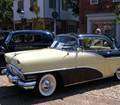|
How Packard Builds a Body c1930
|
||||
|---|---|---|---|---|
|
Forum Ambassador
|
This thread How Packard Builds a Body c1930 on the AACA Website contains 3 films about Packard wood body building. Enjoy.
O_D there's a TPN in the last scene of the 3rd film. If you can identify it, wouldn't it be amazing if it was one of the numbers in your database! 
Posted on: 2014/1/11 3:30
|
|||
|
Mal
/o[]o\ ====  Bowral, Southern Highlands of NSW, Australia "Out of chaos comes order" - Nietzsche. 1938 Eight Touring Sedan - SOLD 1941 One-Twenty Club Coupe - SOLD 1948 Super Eight Limo, chassis RHD - SOLD 1950 Eight Touring Sedan - SOLD What's this?  Put your Packard in the Packard Vehicle Registry! Here's how! Any questions - PM or email me at ozstatman@gmail.com |
||||
|
||||
|
Re: How Packard Builds a Body c1930
|
||||
|---|---|---|---|---|
|
Home away from home

|
The silent Packard film, Part 3, really drives home the complexity in making a fine car with a wood-framed body. Even with the metal jigs to keep bodies somewhat consistent, I'm sure a slap with a mallet or trim with a wood file is inherent in the history of these cars. As for the behavior in a collision, you need look no further that that interesting drive down (Wilsher?) the 1935 Los Angeles street in another film that was shared on PI earlier this week. For a few seconds you see a tow truck hauling a virtually collapsed wreck of a sedan. The next likely fate for that car might be a bonfire and I wonder how well the occupants fared?
My grandmother's household once had an early 1920's Nash touring car that was hit from the side. Since it was then a relatively new car, no authorized repairs could apparently be made in St. Louis and the car was shipped off to Kenosha for rebuilding. It was gone three months and was apparently still unsatisfactory when it was returned. That began a steady series of Packard purchases by the family until they switched to Buicks after WW II. Luckily, none of those Packards got hit or the brand switching might have affected them, too. In St. Louis, when 1954 Corvette production shifted from Flint, operations were set up in the circa-1919 "Mill Building" (plant 19). That building had been largely under-utilized after Chevrolets moved to "all steel Turret Top" construction in 1933-34. Perhaps some might think that making cars out of fiberglass instead of wood was a natural progression. With many additions and modifications, that Mill Building cranked out Corvettes until 1981.
Posted on: 2014/1/11 13:48
|
|||
|
||||
|
Re: How Packard Builds a Body c1930
|
||||
|---|---|---|---|---|
|
Home away from home

|
I have a picture of a 733 Dual Cowl that was hit by a tractor trailer on the NJ Turnpike. Utterly destroyed.
Posted on: 2014/1/11 17:45
|
|||
|
||||








